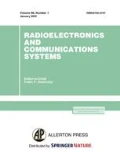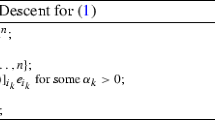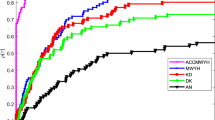Abstract
Discrete orthogonal transforms including the discrete Fourier transform, the discrete Walsh transform, the discrete Hartley transform, the discrete Slant transform, etc. are extensively used in radio-electronic and telecommunication systems for data processing and transmission. The popularity of using these transform is explained by the presence of fast algorithms that minimize the computational and hardware complexity of their implementation. A special place in the list of transforms is occupied by the forward and inverse discrete cosine transforms (FDCT and IDCT respectively). This article proposes a set of parallel algorithms for the fast implementation of FDCT/IDCT. The effectiveness of the proposed solutions is justified by the possibility of the factorization of the FDCT/IDCT matrices, which leads to a decrease in computational and implementation complexity. Some fully parallel FDCT/IDCT algorithms for small lengths N = 2, 3, 4, 5, 6, 7 are presented.
Similar content being viewed by others
References
N. Ahmed, K. R. Rao, Orthogonal Transforms for Digital Signal Processing (Springer, 1975). DOI: https://doi.org/10.1007/978-3-642-45450-9.
Douglas F. Elliott, K. Ramamohan Rao, Fast Transforms: Algorithms, Analyses, Applications (Academic Press, 1983).
Guoan Bi, Yonghong Zeng, Transforms and Fast Algorithms for Signal Analysis and Representations (Birkhäuser, 2004). DOI: https://doi.org/10.1007/978-0-8176-8220-0.
R. E. Blahut, Fast Algorithms for Digital Signal Processing (CUP, 2010). DOI: https://doi.org/10.1017/CBO9780511760921.
N. Ahmed, T. Natarajan, K. R. Rao, “Discrete cosine transform,” IEEE Trans. Comput. C-23, No. 1, 90 (Jan. 1974). DOI: https://doi.org/10.1109/T-C.1974.223784.
K. R. Rao, P. Yip, Discrete Cosine Transform: Algorithms, Advantages, Applications (Academic Press, New York, 1990).
V. Britanak, P. C. Yip, K. R. Rao, Discrete Cosine and Sine Transforms: General Properties, Fast Algorithms and Integer Approximations (Academic Press Inc., Elsevier Science, Amsterdam, 2006). DOI: https://doi.org/10.1016/B978-0-12-373624-6.X5000-0.
B. Chitprasert, K. R. Rao, “Discrete cosine transform filtering,” Signal Processing19, No. 3, 233 (Mar. 1990). DOI: https://doi.org/10.1016/0165-1684(90)90115-F.
Humberto Ochoa-Dominguez, K. R. Rao, Discrete Cosine Transform, 2nd ed. (CRC Press, 2019).
D. Salomon, Data Compression: The Complete Reference, 3rd ed. (Springer, 2004). DOI: https://doi.org/10.1007/978-1-84628-603-2.
K. Sayood, Introduction to Data Compression, 5th ed. (Elsevier, 2006). URI: {rs https://www.elsevier.com/books/introduction-to-data-compression/sayood/978-0-12-809474-7}.
M. Puschel, J. M. F. Moura, “Algebraic signal processing theory: Cooley-Tukey type algorithms for DCTs and DSTs,” IEEE Trans. Signal Process. 56, No. 4, 1502 (April 2008). DOI: https://doi.org/10.1109/TSP.2007.907919.
S. F. Chang, D. G. Messerschmitt, “A new approach to decoding and compositing motion-compensated DCT-based images,” Proc. of IEEE ICASSP, 27–30 Apr. 1993, Minneapolis, USA (IEEE, 1993). DOI: https://doi.org/10.1109/ICASSP.1993.319837.
L. Krikor, S. Baba, T. Arif, Z. Shaaban, “Image encryption using DCT and stream cipher,” European J. Sci. Res. 32, No. 1, 48 (2009).
M. Ptáček, “Digitální zpracování a přenos obrazové informace,” Nakladatelství dopravy a spojů (NADAS, Praha, 1983).
Herve Benoit, Digital Television, 2nd ed. (Focal Press, 2002). URI: {rs https://www.oreilly.com/library/view/digital-television-2nd/9780240516950/}.
W. Fischer, Digital Television: A Practical Guide for Engineers (Springer Science & Business Media, 2004). DOI: https://doi.org/10.1007/978-3-662-05429-1.
J. Arnold, M. Frater, M. Pickering, Digital Television: Technology and Standards, 1st ed. (Wiley-Interscience, 2007). URI: {rs https://www.wiley.com/en-us/Digital+Television%3A+Technology+and+Standards-p-9780470173411}.
J. R. Hernandez, M. Amado, F. Perez-Gonzalez, “DCT-domain watermarking techniques for still images: detector performance analysis and a new structure,” IEEE Trans. Image Process. 9, No. 1, 55 (2000). DOI: https://doi.org/10.1109/83.817598.
A. G. Bors, I. Pitas, “Image watermarking using DCT domain constraints,” Proc. IEEE. Int. Conf. on Image Processing, 19 Sept. 1996, Lausanne, Switzerland (IEEE, 1996), pp. 231–234. DOI: https://doi.org/10.1109/ICIP.1996.560426.
M. A. Suhail, M. S. Obaidat, “Digital watermarking-based DCT and JPEG model,” IEEE Trans. Instrumentation Meas. 52, No. 5, 1640 (2003). DOI: https://doi.org/10.1109/TIM.2003.817155.
W. C. Chu, “DCT-based image watermarking using subsampling,” IEEE Trans. Multimedia5, No. 1, 34 (Mar. 2003). DOI: https://doi.org/10.1109/TMM.2003.808816.
Jeonghee Jeon, Sang-Kwang Lee, Yo-Sung Ho, “A three-dimensional watermarking algorithm using the DCT transform of triangle strips,” Int. Workshop Digital Watermarking, IWDW 2003: Lecture Notes in Computer Science book series (LNCS, 2003), Vol. 2939, pp. 508–517. DOI: https://doi.org/10.1007/978-3-540-24624-4_41.
Marwa Chafii, Justin P. Coon, Dene A. Hedges, “DCT-OFDM with index modulation,” IEEE Commun. Lett. 21, No. 7, 1489 (2017). DOI: https://doi.org/10.1109/LCOMM.2017.2682843.
Dwi Astharini, Dadang Gunawan, “Discrete cosine transform and pulse amplitude modulation for visible light communication with unequally powered multiple access,” Proc. of 2018 2nd Int. Conf. on Applied Electromagnetic Technology, AEMT, 9–12 Apr. 2018, Lombok, Indonesia (IEEE, 2018), pp. 1–5. DOI: https://doi.org/10.1109/AEMT.2018.8572430.
W.-H. Chen, C. Smith, S. Fralick, “A fast computational algorithm for the discrete cosine transform,” IEEE Trans. Commun. 25, No. 9, 1004 (1977). DOI: https://doi.org/10.1109/TCOM.1977.1093941.
B. Lee, “A new algorithm to compute discrete cosine transform,” IEEE Trans. Acoust., Speech, Signal Processing32, No. 6, 1243 (Dec. 1984). DOI: https://doi.org/10.1109/TASSP.1984.1164443.
Y. Arai, T. Agui, M. Nakajima, “A fast DCT-SQ scheme for images,” IEICE Trans. Fundamentals Electron., Commun. Computer Sci. 71, No. 11, 1095 (1988). URI: {rs https://scinapse.io/papers/2062271532}.
C. Loeffler, A. Ligtenberg, G. S. Moschytz, “Practical fast 1-D DCT algorithms with 11 multiplications,” Proc. of Int. Conf. on Acoustics, Speech, and Signal Processing, 23–26 May 1989, Glasgow, UK (IEEE, 1989), pp. 988–991. DOI: https://doi.org/10.1109/ICASSP.1989.266596.
C. W. Kok, “Fast algorithm for computing discrete cosine transform,” IEEE Trans. Signal Processing45, No. 3, 757 (1997). DOI: https://doi.org/10.1109/78.558495.
E. Feig, S. Winograd, “Fast algorithms for the discrete cosine transform,” IEEE Trans. Signal Processing40, No. 9, 2174 (1992). DOI: https://doi.org/10.1109/78.157218.
B. Tseng, W. Miller, “On computing the discrete cosine transform,” IEEE Trans. Comput. C-27, No. 10, 966 (1978). DOI: https://doi.org/10.1109/TC.1978.1674977.
J. Makhoul, “A fast cosine transform in one and two dimensions,” IEEE Trans. Acoust., Speech, Signal Processing28, No. 1, 27 (1980). DOI: https://doi.org/10.1109/TASSP.1980.1163351.
M. Vetterli, H. J. Nussbaumer, “Simple FFT and DCT algorithms with reduced number of operations,” Signal Process. 6, No. 4, 267 (1984). DOI: https://doi.org/10.1016/0165-1684(84)90059-8.
H. S. Malvar, “Fast computation of discrete cosine transform through fast Hartley transform,” Electron. Lett. 22, No. 7, 352 (1986). DOI: https://doi.org/10.1049/el:19860239.
M. Haque, “A two-dimensional fast cosine transform,” IEEE Trans. Acoust., Speech, Signal Processing33, No. 6, 1532 (1985). DOI: https://doi.org/10.1109/TASSP.1985.1164737.
H. S. Hou, “A fast recursive algorithm for computing the discrete cosine transform,” IEEE Trans. Acoust., Speech, Signal Processing35, No. 10, 1455 (1987). DOI: https://doi.org/10.1109/TASSP.1987.1165060.
H. R. Wu, F. J. Paoloni, “The structure of vector radix fast Fourier transforms,” IEEE Trans. Acoust., Speech, Signal Processing37, No. 9, 1415 (1989). DOI: https://doi.org/10.1109/29.31295.
S. C. Chan, K. L. Ho, “Direct methods for computing discrete sinusoidal transforms,” IEEE Proc. F: Radar Signal Process. 137, No. 6, 433 (Dec. 1990). DOI: https://doi.org/10.1049/ip-f-2.1990.0063.
Nam Ik Cho, San Uk Lee, “Fast algorithm and implementation of 2-D discrete cosine transform,” IEEE Trans. Circuits Syst. 38, No. 3, 297 (1991). DOI: https://doi.org/10.1109/31.101322.
C. A. Christopoulos, A. N. Skodras, “On the computation of the fast cosine transform,” Proc. ECCTD-Circuit Theory and Design (1993), pp. 1037–1042.
Y.-H. Chan, W.-C. Siu, “Mixed-radix discrete cosine transform,” IEEE Trans. Signal Process. 41, No. 11, 3157 (1993). DOI: https://doi.org/10.1109/78.257281.
Yu-Tai Chang, Chin-Liang Wang, “A new fast DCT algorithm and its systolic VLSI implementation,” IEEE Trans. Circuits Systems II: Analog Digital Signal Processing44, No. 11, 959 (1997). DOI: https://doi.org/10.1109/82.644050.
Y. Jeong, I. Lee, H. S. Kim, K. T. Park, “Fast DCT algorithm with fewer multiplication stages,” Electron. Lett. 34, No. 8, 723 (1998). DOI: https://doi.org/10.1049/el:19980533.
J. Kwak, J. You, “One- and two-dimensional constant geometry fast cosine transform algorithms and architectures,” IEEE Trans. Signal Processing47, No. 7, 2023 (1999). DOI: https://doi.org/10.1109/78.771049.
J. Takala, D. Akopian, J. Astola, J. Saarinen, “Constant geometry algorithm for discrete cosine transform,” IEEE Trans. Signal Processing48, No. 6, 1840 (2000). DOI: https://doi.org/10.1109/78.845951.
G. Bi, G. Li, K.-K. Ma, T. C. Tan, “On the computation of two-dimensional DCT,” IEEE Trans. Signal Process. 48, No. 4, 1171 (Apr. 2000). DOI: https://doi.org/10.1109/78.827550.
Jiun-In Guo, “A low cost 2-D inverse discrete cosine transform design for image compression,” Proc. of 2001 IEEE Int. Symp. on Circuits and Systems, 6–9 May 2001, Sydney, Australia (IEEE, 2001), Vol. 4, pp. 658–661. DOI: https://doi.org/10.1109/ISCAS.2001.922323.
X. Shao, S. G. Johnson, “Type-II/III DCT/DST algorithms with reduced number of arithmetic operations,” Signal Processing88, No. 6, 1553 (2008). DOI: https://doi.org/10.1016/j.sigpro.2008.01.004.
W. B. Pennebaker, J. L. Mitchell, JPEG still Image Data Compression Standard (Van Nostrand Reinhold, New York, 1993). URI: {rs https://www.springer.com/gp/book/9780442012724}.
Pei-Zong Lee, Fang-Yu Huang, “An efficient prime-factor algorithm for the discrete cosine transform and its hardware implementations,” IEEE Trans. Signal Processing42, No. 8, 1996 (1994). DOI: https://doi.org/10.1109/78.301838.
A. Tatsaki, C. Dre, T. Stouraitis, C. Goutis, “On the computation of the prime factor DST,” Signal Processing42, No. 3, 231 (1995). DOI: https://doi.org/10.1016/0165-1684(94)00132-J.
A. Tatsaki, C. Dre, T. Stouraitis, C. Goutis, “Prime-factor DCT algorithms,” IEEE Trans. Signal Processing43, No. 3, 772 (1995). DOI: https://doi.org/10.1109/78.370632.
Guoan Bi, Yonghong Zeng, Yen Qiu Chen, “Prime factor algorithm for multidimensional discrete cosine transform,” IEEE Trans. Signal Processing49, No. 9, 2156 (2001). DOI: https://doi.org/10.1109/78.942642.
S.-K. Lu, C.-W. Wu, S.-Y. Juo, “Design of easily testable VLSI arrays for discrete cosine transform,” Proc. of Twenty-Sixth Asilomar Conf. on Signals Systems and Computers, 26–28 Oct. 1992. Pacific Grove, USA (IEEE, 1992), Vol. 2, pp. 989–993. DOI: https://doi.org/10.1109/ACSSC.1992.269072.
S.-W. Lee, W.-H. Hsu, “Parallel implementation of prime-factor discrete cosine transform on the orthogonal multiprocessor,” IEEE Trans. Circuits Systems Video Technol. 3, No. 2, 107 (1993). DOI: https://doi.org/10.1109/76.212717.
N. Rama Murthy, M. N. S. Swamy, “On the real-time computation of DFT and DCT through systolic architectures,” IEEE Trans. Signal Processing42, No. 4, 988 (1994). DOI: https://doi.org/10.1109/78.285671.
K.-W. Shin, H.-W. Jeon, Y.-S. Kang, “An efficient VLSI implementation of vector-radix 2-D DCT using mesh-connected 2-D array,” Proc. of IEEE Int. Symp. on Circuits and Systems, 30 May–2 June 1994, London, UK (IEEE, 1994), Vol. 4, pp. 47–50. DOI: https://doi.org/10.1109/ISCAS.1994.409193.
Chin-Liang Wang, Chang-Yu Chen, “High-throughput VLSI architectures for the 1-D and 2-D discrete cosine transforms,” IEEE Trans. Circuits Systems Video Technology5, No. 1, 31 (1995). DOI: https://doi.org/10.1109/76.350776.
Shih-Chang Hsia, Bin-Da Liu, Jar-Ferr Yang, Bor-Long Bai, “VLSI implementation of parallel coefficient-by-coefficient two-dimensional IDCT processor,” IEEE Trans. Circuits Systems Video Technology5, No. 5, 396 (1995). DOI: https://doi.org/10.1109/76.473561.
Hyesook Lim, E. E. Swartzlander, “An efficient systolic array for the discrete cosine transform based on prime-factor decomposition,” Proc. of 1995 Int. Conf. on Computer Design. VLSI in Computers and Processors, 2–4 Oct. 1995, Austin, USA (IEEE, 1995), pp. 644–649. DOI: https://doi.org/10.1109/ICCD.1995.528936.
Yu-Tai Chang, Chin-Liang Wang, “Systolic architecture for inverse discrete cosine transform,” Electron. Lett. 31, No. 21, 1809 (1995). URI: https://ieeexplore.ieee.org/abstract/document/8840699.
A. Madisetti, A. N. Willson, “A 100 MHz 2-D 8×8 DCT/IDCT processor for HDTV applications,” IEEE Trans. Circuits Systems Video Technol. 5, No. 2, 158 (1995). DOI: https://doi.org/10.1109/76.388064.
V. Srinivasan, K. J. R. Liu, “VLSI design of high-speed time-recursive 2-D DCT/IDCT processor for video applications,” IEEE Trans. Circuits Syst. Video Technol. 6, No. 1, 87 (1996). DOI: https://doi.org/10.1109/76.486423.
C. V. Schimpfle, P. Rieder, J. A. Nossek, “A power efficient implementation of the discrete cosine transform,” Proc. of Thirty-First Asilomar Conf. on Signals, Systems and Computers, 2–5 Nov. 1997, Pacific Grove, USA (IEEE, 1997), Vol. 1, pp. 729–733. DOI: https://doi.org/10.1109/ACSSC.1997.680540.
Y.-P. Lee, T.-H. Chen, L.-G. Chen, M.-J. Chen, C.-W. Ku, “A cost-effective architecture for 8×8 two-dimensional DCT/IDCT using direct method,” IEEE Trans. Circuits Syst. Video Technol. 7, No. 3, 459 (1997). DOI: https://doi.org/10.1109/76.585925.
Yu-Tai Chang, Chin-Liang Wang, “A new fast DCT algorithm and its systolic VLSI implementation,” IEEE Trans. Circuits Systems II: Analog Digital Signal Processing44, No. 11, 959 (1997). DOI: https://doi.org/10.1109/82.644050.
M. A. BenAyed, L. Dulau, P. Nouel, Y. Berthoumieu, N. Masmoudi, P. Kadionik, L. Kamoun, “New design using a VHDL description for DCT based circuits,” Proc. of ICM’98, 16 Dec. 1998, Monastir, Tunisia (IEEE, 1998), pp. 87–90. DOI: https://doi.org/10.1109/ICM.1998.825575.
L.-G. Chen, J.-Y. Jiu, H.-C. Chang, Y.-P. Lee, C.-W. Ku, “A low power 2D DCT chip design using direct 2D algorithm,” Proc. of Asia and South Pacific Design Automation Conf., 13 Feb. 1998, Yokohama, Japan (IEEE, 1998), pp. 145–150. DOI: https://doi.org/10.1109/ASPDAC.1998.669434.
Chung-Yen Lu, Kuei-Ann Wen, “On the design of selective coefficient DCT module,” IEEE Trans. Circuits Systems Video Technology8, No. 2, 143 (1998). DOI: https://doi.org/10.1109/76.664099.
S.-F. Hsiao, W.-R. Shiue, J.-M. Tseng, “A cost-efficient and fully-pipelinable architecture for DCT/IDCT,” IEEE Trans. Consumer Electron. 45, No. 3, 515 (1999). DOI: https://doi.org/10.1109/30.793535.
K. Kim, J.-S. Koh, “An area efficient DCT architecture for MPEG-2 video encoder,” IEEE Trans. Consumer Electron. 45, No. 1, 62 (1999). DOI: https://doi.org/10.1109/30.754418.
T.-S. Chang, C.-S. Kung, C.-W. Jen, “A simple processor core design for DCT/IDCT,” IEEE Trans. Circuits Syst. Video Technol. 10, No. 3, 439 (2000). DOI: https://doi.org/10.1109/76.836290.
Hyesook Lim, V. Piuri, E. E. Swartzlander, “A serial-parallel architecture for two-dimensional discrete cosine and inverse discrete cosine transforms,” IEEE Trans. Computers49, No. 12, 1297 (2000). DOI: https://doi.org/10.1109/12.895848.
Min Jiang, Yuan Luo, Yiling Fu, Bing Yang, Baoying Zhao, Xin-an Wang, Shimin Sheng, Tianyi Zhang, “A low power 1D-DCT processor for MPEG-targeted real-time applications,” Proc. of IEEE Int. Symp. on Communications and Information Technology, 26–29 Oct. 2004, Sapporo, Japan (IEEE, 2004), Vol. 2, pp. 682–687. DOI: https://doi.org/10.1109/ISCIT.2004.1413802.
S. P. Mohanty, N. Ranganathan, K. Balakrishnan, “A dual voltage-frequency VLSI chip for image watermarking in DCT domain,” IEEE Trans. Circuits Syst. II Exp. Briefs53, No. 5, 394 (2006). DOI: https://doi.org/10.1109/TCSII.2006.870216.
F. Qureshi, M. Garrido, O. Gustafsson, “Unified architecture for 2, 3, 4, 5, and 7-point DFTs based on Winograd Fourier transform algorithm,” Electron. Lett. 49, No. 5, 348 (2013). DOI: https://doi.org/10.1049/el.2012.0577.
H. M. De Oliveira, R. J. Cintra, R. M. Campello de Souza, “A factorization scheme for some discrete Hartley transform matrices,” 1 (2015). arXiv:1502.01038.
A. Cariow, J. Papliñski, D. Majorkowska-Mech, “Some structures of parallel VLSI-oriented processing units for implementation of small size discrete fractional Fourier transforms,” Electronics8, No. 5, 509 (2019). DOI: https://doi.org/10.3390/electronics8050509.
Yu. A. Reznik, Ravi K. Chivukula, “Design of fast transforms for high-resolution image and video coding,” Proc. SPIE 7443, Applications of Digital Image Processing XXXII, 744312 (2 Sept. 2009). DOI: https://doi.org/10.1117/12.831216.
V. Britanak, K. R. Rao, Cosine-/Sine-Modulated Filter Banks: General Properties, Fast Algorithms and Integer Approximations (Springer, 2018). DOI: https://doi.org/10.1007/978-3-319-61080-1.
Trac D. Tran, Jie Liang, Chengjie Tu, “Lapped transform via time-domain pre- and post-filtering,” IEEE Trans. Signal Processing51, No. 6, 1557 (2003). DOI: https://doi.org/10.1109/TSP.2003.811222.
A. Þariov, D. Majorkowska-Mech, “The multilevel signal representation in discrete base of cosine functions,” Elektronika: konstrukcje technologie zastosowania48, No. 7, 20 (2007).
V. M. Chernov, M. A. Chicheva, “One-step’ short-length DCT algorithms with data representation in the direct sum of the associative algebras,” in: Sommer, G.; Daniilidis, K.; Pauli, J. (eds.), Computer Analysis of Images and Patterns. CAIP 1997. Lecture Notes in Computer Science (Springer, Berlin, Heidelberg, 1997), Vol. 1296, pp. 590–596. DOI: https://doi.org/10.1007/3-540-63460-6_167.
A. Þariov, Algorytmiczne aspekty racjonalizacji obliczeñ w cyfrowym przetwarzaniu sygna³ów (in Polish) [Algorithmic aspects of computing rationalization in Digital Signal processing] (West Pomeranian University Press, 2012).
A. Cariow, “Strategies for the synthesis of fast algorithms for the computation of the matrix-vector products,” J. Signal Processing Theory Applications, No. 3, 1 (2014). DOI: https://doi.org/10.7726/jspta.2014.1001.
A. Graham, Kronecker Products and Matrix Calculus: With Applications (Ellis Horwood Limited, Chichester, England, 1981).
P. A. Regalia, S. K. Mitra, “Kronecker products, unitary matrices and signal processing applications,” SIAM Review31, No. 4, 586 (1989). DOI: https://doi.org/10.1137/1031127.
J. Granata, M. Conner, R. Tolimieri, “The tensor product: A mathematical programming language for FFTs and other fast DSP operations,” IEEE Signal Process. Mag. 9, No. 1, 40 (1992). DOI: https://doi.org/10.1109/79.109206.
Author information
Authors and Affiliations
Corresponding authors
Additional information
Russian Text © The Author(s), 2019, published in Izvestiya Vysshikh Uchebnykh Zavedenii, Radioelektronika, 2019, Vol. 62, No. 11, pp. 662–677
About this article
Cite this article
Cariow, A., Makowska, M. & Strzelec, P. Small-Size FDCT/IDCT Algorithms with Reduced Multiplicative Complexity. Radioelectron.Commun.Syst. 62, 559–576 (2019). https://doi.org/10.3103/S0735272719110025
Received:
Revised:
Accepted:
Published:
Issue Date:
DOI: https://doi.org/10.3103/S0735272719110025




